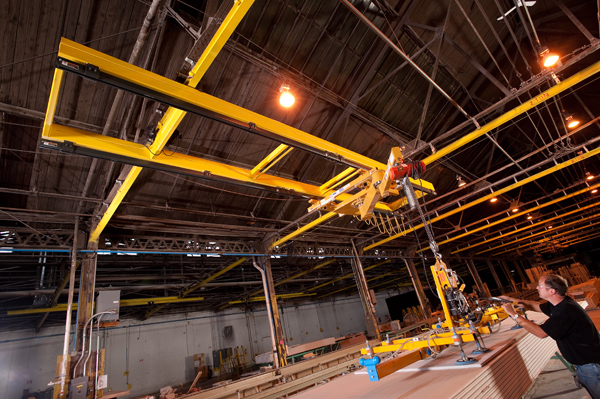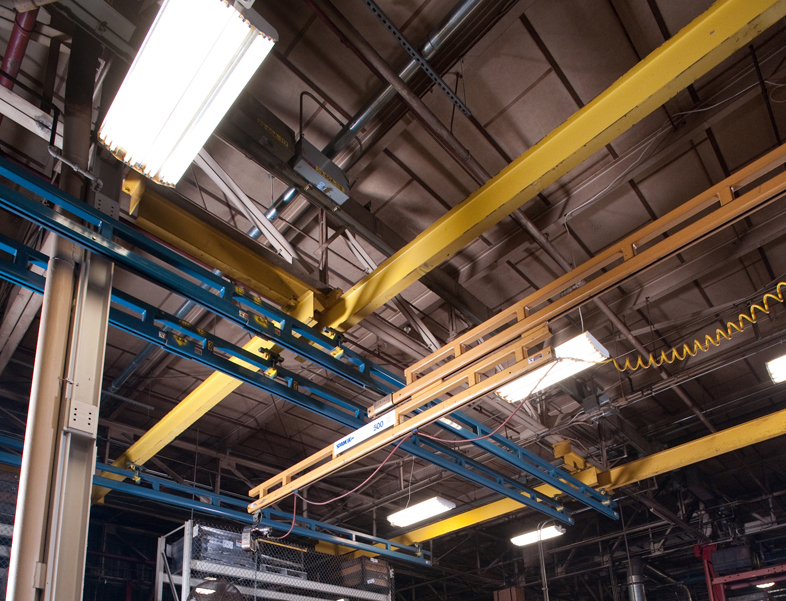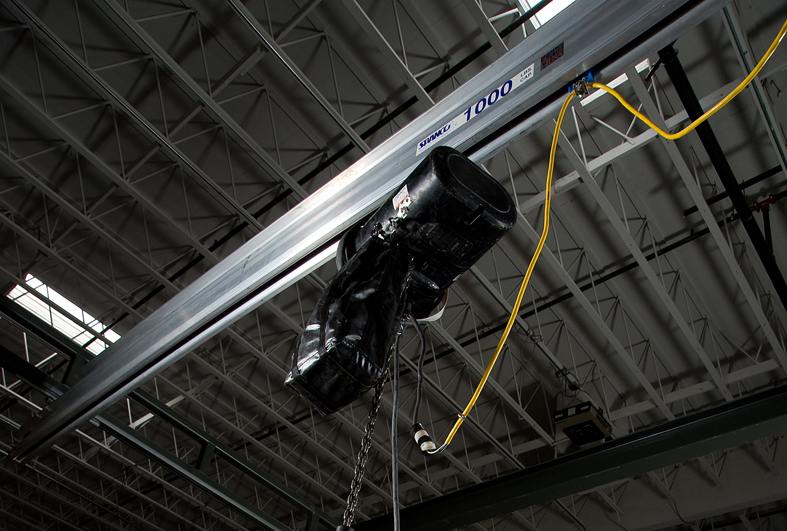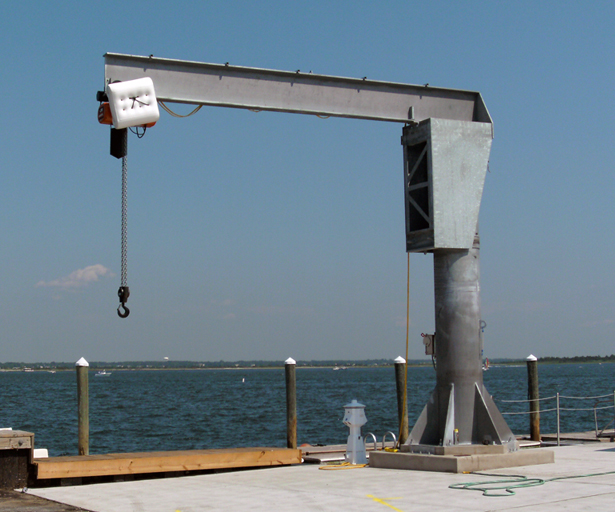
Customizing Your Crane
May 15, 2014
Although we’ve covered “Selecting the Right Overhead Crane” in a previous blog post, it’s important to note that some operations require specific components that can be slightly altered to customize a system. In that case, you can work with a qualified crane manufacturer to develop a system that meets the needs of your application.
Developing a system that meets the needs of your application doesn’t necessarily mean creating a brand new overhead crane. Usually, a qualified manufacturer can recommend specific components or even make small changes to the crane’s structure to make it more efficient for your operation.
The following list highlights unique examples of pre-engineered systems and components that can be slightly altered or used unconventionally for a particular application.
1.) Articulating Jib mounted to a bridge crane to increase the scope of coverage and extend the functionality of the system:
Mounting an articulating jib on an existing bridge crane is not unheard of. It is, however, a unique combination that demonstrates how flexible overhead crane systems can be. If your bridge crane isn’t providing adequate coverage or you need more versatility to improve the efficiency of your operation, mounting an articulating jib directly on your bridge crane might be the answer.
Articulating jib cranes can lift loads around corners and columns, reach into machinery and containers, and service any point between the pivot anchor and the far reach of the boom.
An articulating jib crane provides 200-degree rotation for the inner arm, and 360-degree rotation for the outer arm. Their outstanding headroom allows them to be installed in tight locations such as low ceilings or crowded facilities.
2.) Dual Telescoping Bridge Crane to extend crane reach beyond runways on both ends:
If you’re looking to install an overhead crane for a busy factory floor, you may consider installing a ceiling mounted bridge crane. The ceiling mounted crane will free up floor space and provide increased efficiency in your operation.
But, if you need a ceiling mounted bridge crane that is designed to reach beyond the runways to lift materials from aisles or small spaces outside of your crane’s coverage area, you can extend your crane’s reach by including a telescoping bridge.
Including a telescoping bridge is relatively simple, but what if you need the bridge crane to extend past its runways on both ends? Your crane manufacturer might recommend installing a customized dual telescoping bridge to extend reach in both directions.
Telescoping bridges allow you to easily place parts into machinery or into a nearby workstation. Dual telescopic bridge cranes also enable you to reach beyond a support column or under a mezzanine on either side of the system. Anti-kick-up wheels keep the telescoping bridge’s movement smooth, even when carrying up to 2,000 pounds.
3.) Mixed Capacity Bridge Cranes to leverage system capability and reduce bridge dead weight:
Using heavier capacity runways with multiple smaller capacity bridges will help to leverage your system’s capability and provide multiple lift solutions within one coverage area.
For instance, a 2,000-pound capacity runway can run two 1,000-pound bridges or four 500-pound bridges. Not only does it leverage system capability and offer more flexibility, it also reduces bridge dead weight. Workers can use multiple bridges side-by-side to transport loads without overloading the system.
4.) Aluminum Track Bridge Cranes and Runways to reduce the overall system weight and increase spanning capabilities:
Aluminum track bridge cranes provide a unique material handling solution for facilities where lower bridge weight is essential. Aluminum track systems mean less weight on your roof support structure.
The low weight also results in easier movement, which can improve safety and productivity in work areas.
Our aluminum track systems, for example, can span up to 29 feet—depending on desired capacity—and the aluminum enclosed track provides spark resistant, durable, maintenance-free, and non-corroding performance that is well suited for clean rooms, refrigerated areas, acidic environments, R&D labs, moisture-laden environments, and anywhere requiring lightweight durable enclosed track systems.
Aluminum track systems are extremely flexible because they allow interchangeable use of aluminum bridges on steel runways. Aluminum bridges work with aluminum runways and steel runways, and aluminum monorail systems are a great option for applications that need full coverage of the facility.
5.) Nylacron™ Wheels to improve system portability and enable easy gantry travel over uneven or rocky surfaces:
The use of Nylacron™ wheels can be especially helpful for applications requiring a non-motorized gantry crane that is totally portable.
Low-capacity gantry cranes operating on flat, even surfaces may only require standard pneumatic wheels to function adequately. But, if your application requires a system that can travel easily over uneven or rocky surfaces, Nylacron™ wheels are a great customization.
They also work well with larger, non-motorized gantry cranes. Using Nylacron™ wheels can enable one worker to move an entire system under load with minimal effort.
The 12-inch diameter Nylacron™ wheels with heavy-duty bearings and four-position swivel locks are made of durable, highly compressed cast polyamide for increased load capacity and low rolling resistance.
Nylacron™ wheels are often used to replace cast iron, steel, phenolic, solid elastomer, and urethane wheels for applications that require high load capacity, impact resistance, easy movement, and floor protection.
6.) Galvanized Steel protect crane system from rust and corrosion:
Most overhead crane manufacturers offer multiple protective coating options to prevent steel components from rusting in caustic environments.
Some common paint finishes and protective coatings include two-component epoxy, galvanized steel, polyurethane, and industrial enamel. Each paint finish has its own set of advantages depending on your application.
For extremely corrosive applications where UV exposure or salt water is a concern, galvanized steel is extremely effective. In the galvanizing process, steel is coated with zinc to protect it from corrosion.
Hot dip galvanizing provides thick, durable corrosion protection, which is perfect for marine applications, offshore platforms, and water treatment plants. Galvanized steel will also protect your crane system against abrasion, corrosive fluids, turbulence, heat, cold, and impact forces.
7.) Single Leg Gantry Cranes for facilities that can’t fit a standard PF Series Gantry:
A single leg gantry crane provides material handling solutions for operations in narrow and confined spaces or near crowded machinery. Single leg gantries (also known as semi gantries) provide high capacity lift solutions while also maximizing your space utilization.
Single leg gantries operate with one leg moving over the floor on wheels as the other end travels overhead on a wall-mounted I-beam using a top running end truck design.
Categories
Share this post
Contact us
Looking for the perfect fall protection equipment? Let us help!



